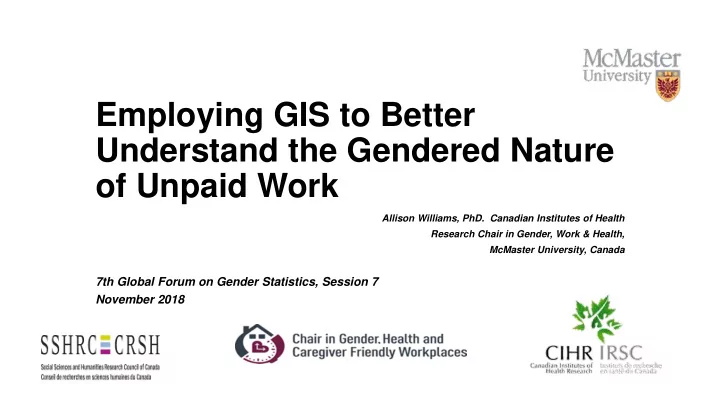

Employing GIS to Better Understand the Gendered Nature of Unpaid Work Allison Williams, PhD. Canadian Institutes of Health Research Chair in Gender, Work & Health, McMaster University, Canada 7th Global Forum on Gender Statistics, Session 7 November 2018
Unpaid Care Work • Universal • Social, Cultural, Policial contexts vary geographically • Impacted by the social determinants of health • Gendered • Time-space tensions = negative outcomes for carers • Carer-employees • Carer-Friendly Workplaces
Spatial & Temporal Tensions
What is the Economic Impact? (Research on Aging Policies & Practices, University of Alberta) > $1.3 billion lost per year 5
A New World of Research Opportunity ➢ GIS – Geographical Information Science 1. Measuring Spatial Access to Health/Social Care Services 2. Critical/Feminist geographies - Measuring Time-Space Vulnerability
Census Tracts GPS Tracking Time-Use Data Gender Occupational Status
Limited Spatial Data Availability for Time-Use Data Home Domestic Work Caregiving Care/Maintenance • Meal • Financial • Physical & prep/cleaning management medical care • Clothing care • Plant/garden • Education care • Cleaning • Other care • Home • Shopping • Travel related to management caregiving • Obtaining services
Axis of Time vs. Axis of Space Time Space • Unpaid work has traditionally • Unpaid work has not yet been been examined temporally fully explored across space & provides an exciting opportunity • Axis of time prioritized via for enhanced understanding weekly/daily time-use surveys, through visualization etc. • Spatial data required!
Current/Established Applications (1) 1. Measuring Spatial Access to Health/Social Care Services • People – locations, numbers, demographic, health needs • Providers – locations, numbers, characteristics, quality, acceptability • Proximity – distance, travel time, transportation access Used for Planning • Primary care • Social care • Adjunct services
Using GIS to characterize neighborhood environments Miranda et al (2002) Mapping for prevention: GIS models for directing childhood lead poisoning programs. Envir Health Persp, 110:947-953
Study Area (Dardas et al., 2018)
Service Zones with/out Public Transit (Dardas et al., 2018)
Accessibility Scores with/out Public Transit (Dardas et al., 2018)
Potential Demand Zones (Dardas et al., 2018)
Space-Time Series
Novel & Developing Applications (2) 2. Critical/Feminist Approaches to Measuring Time-Space Vulnerability • Non-employment activities (inclusive of unpaid work) • Volunteered Geographic Information (VGI)
A close-up view of activity patterns in geographic space (Kwan, 2000)
Gendered Experience (Kwan, 2000) Space-time activity density of non- Space-time activity density of non- employment activities for women employed employment activities for men employed part-time part-time
Gender difference in the density of non- employment activities between women and men employed part-time (Kwan, 2000)
Females Underreporting (Ferster et al, 2017)
Activity spaces do not correspond to geopolitical units HOME Mother ’ s home Shopping Work Day Care Concept mapping (Burke et al. 2005)
Opportunities • Unpaid work in time & space in its inception • volunteered geographic information (VGI) = low hanging fruit • Data availability geographically variable across the globe • Policy/practice implications
Thank you! Questions/Comments? awill@mcmaster.c .ca https://ghw.mcmaster.ca/
References Burke, J., O ’ Campo, P., Peak, G., Gielen, A., McDonnell, K., and Trochim, W. (2005). An Introduction to Concept Mapping as a Participatory Public Health Research Method. Qualitative Health Research, 15 (10): 1392 – 1410. Carers Canada. Retrieved from, http://www.carerscanada.ca/carer-facts/ Dardas, A., Williams, A., and DeLuca, P. (2018). Potential Accessibility to Vital Services for Hamiltonian Caregiver- Employees & Decision-Makers: A GIS Analyses. Manuscript Under Review. Ferster, C., Nelson, T., Winters, M., and Laberee, K. (2017). Geographic age and gender representation in volunteered cycling safety data: A case study of BikeMaps.org. Applied Geography, 88: 144 – 150. Kwan, M. (2000). Interactive geovisualization of activity-travel patterns using three-dimensional geographical information systems: a methodological exploration with a large data set. Transportation Research Part C, (2000): 185 – 203. Miranda, M., Dolinoy, D., and Overstreet, A. (2002). Mapping for Prevention: GIS Models for Directing Childhood Lead Poisoning Prevention Programs. Environmental Health Perspectives, 110 (9): 947 – 953. Research on Aging Policies and Practices. (2014, Sept.). Combining care work and paid work: Is it sustainable? University of Alberta.
Recommend
More recommend